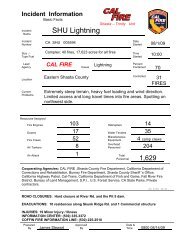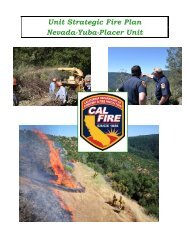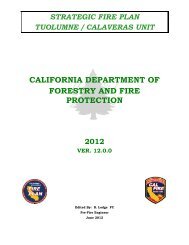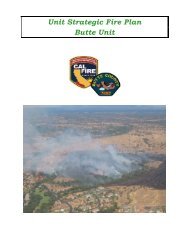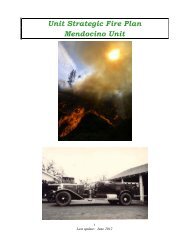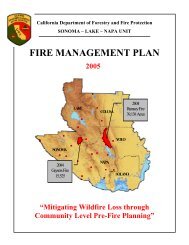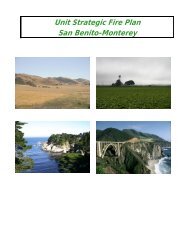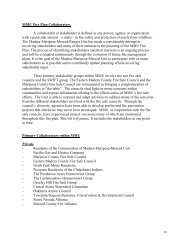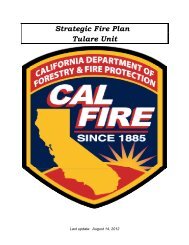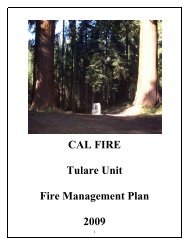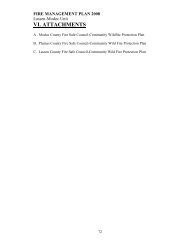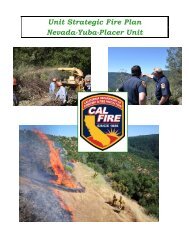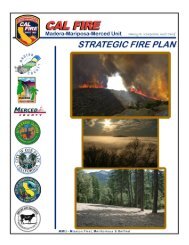Strategic Fire Plan San Diego Unit (MVU) - Board of Forestry and ...
Strategic Fire Plan San Diego Unit (MVU) - Board of Forestry and ...
Strategic Fire Plan San Diego Unit (MVU) - Board of Forestry and ...
You also want an ePaper? Increase the reach of your titles
YUMPU automatically turns print PDFs into web optimized ePapers that Google loves.
SECTION III: Priority L<strong>and</strong>scapes<br />
A: PRIORITY LANDSCAPES: ASSETS AT RISK in CONTEXT OF POTENTIAL THREATS<br />
In the previous fire plan, Assets at Risk were generally presented as a list <strong>of</strong> categories. These<br />
categories usually included topics such as: infrastructure <strong>and</strong> community areas; water <strong>and</strong> air quality;<br />
habitat <strong>and</strong> biological resources; recreation, forest <strong>and</strong> forest products, etc., <strong>and</strong> each category would<br />
describe the specific or local Asset at Risk. Since the previous fire plan, the 2010 Forest <strong>and</strong> Range<br />
Assessment was released to the public. One <strong>of</strong> the products from this assessment provided a new webbased<br />
tool, the Priority L<strong>and</strong>scape Mapper. This Geographical Information Systems (GIS) tool displays<br />
geographically – rather than listing - Assets at Risk in context <strong>of</strong> Potential Threats – <strong>and</strong> identifies this<br />
combined assessment as Priorities L<strong>and</strong>scapes. Moreover, like the <strong>Fire</strong> Hazard Severity Zone Map,<br />
Priority L<strong>and</strong>scapes provides a way to communicate to the public, in a consistent <strong>and</strong> like-way across all<br />
<strong>of</strong> California, the various components <strong>of</strong> the 2010 Forest <strong>and</strong> Range Assessment, including components<br />
related to wildl<strong>and</strong> fire.<br />
Priority L<strong>and</strong>scape Mapper is a comprehensive mapping system that provides spatial analysis for twentytwo<br />
themes. To create these maps, it is best to utilize the website for viewing <strong>and</strong> toggling the options;<br />
plus the mapping s<strong>of</strong>tware allows the selection <strong>of</strong> one <strong>of</strong> four different base maps (satellite imagery,<br />
topographic, road <strong>and</strong> highway, or shade relief) to enhance the viewers underst<strong>and</strong>ing <strong>of</strong> the themes. To<br />
access the Priority Mapper, go to the website: http://frap.cdf.ca.gov/priorityls/default.html. Each theme<br />
relates to one <strong>of</strong> the 11 core themes found in 2010 Forest <strong>and</strong> Range Assessment. To review the full<br />
document, go to the website: http://frap.fire.ca.gov/assessment2010.html.<br />
The <strong>San</strong> <strong>Diego</strong> <strong>Unit</strong> staff has identified 3 priority l<strong>and</strong>scapes that have little to no recorded fire history in<br />
the last 30 years. Within these priority l<strong>and</strong>scapes there has also been an increase in residential <strong>and</strong><br />
community development during this same 30-year period. In these areas identified the l<strong>and</strong>scape has<br />
continuous vegetation, high impact to watershed value <strong>and</strong> an increase to the infrastructure that support<br />
the growing population density. The <strong>San</strong> <strong>Diego</strong> <strong>Unit</strong> staff utilized the Priority L<strong>and</strong>scape Mapper webbased<br />
mapping program <strong>and</strong> identified three areas that are ranked as ‘high threat’ from catastrophic<br />
wildfire. The primary risk factors are 25-30 year growth <strong>of</strong> continuous vegetation, topography alignment<br />
with high wind events <strong>and</strong> wildl<strong>and</strong> urban interface development.<br />
One identified priority l<strong>and</strong>scape at risk is located south <strong>of</strong> the Interstate 8, west <strong>of</strong> Buckman Springs<br />
Road, north <strong>of</strong> Highway 94 <strong>and</strong> east <strong>of</strong> Harbison Canyon <strong>and</strong> Lawson Valley through a portion <strong>of</strong> the<br />
Clevel<strong>and</strong> National Forest. This area is referred to as the Laguna fire foot print that burned in 1970 at<br />
estimated 175,000 acres. This l<strong>and</strong>scape area watershed value supports Lake Morena, Barrett Reservoir<br />
<strong>and</strong> the Lovel<strong>and</strong> Reservoir. Throughout this identified priority l<strong>and</strong>scape are public recreational trails,<br />
camp grounds, <strong>and</strong> scenic overviews. The western edge <strong>of</strong> this priority l<strong>and</strong>scape transitions from open<br />
wildl<strong>and</strong> to an urban interface with a high population density. Project activities can be found in Section V,<br />
under Monte Vista, Dulzura, <strong>and</strong> Campo Battalion <strong>Plan</strong>s.<br />
The next priority l<strong>and</strong>scape area at risk is located along Highway 79 <strong>and</strong> Highway 76, near the<br />
communities <strong>of</strong> Sunshine Summit, Warner Springs <strong>and</strong> Mesa Gr<strong>and</strong>e. This priority l<strong>and</strong>scape has a rich<br />
cultural value due to the numerous Indian Reservation <strong>and</strong> historical sites. This priority l<strong>and</strong>scape area<br />
watershed value supports Vail Lake <strong>and</strong> Lake Henshaw. Project activities can be found in Section V,<br />
Julian Battalion plan.<br />
The third priority l<strong>and</strong>scape area at risk is located in the north central area <strong>of</strong> <strong>San</strong> <strong>Diego</strong> County that<br />
starts in near the community <strong>of</strong> Rainbow <strong>and</strong> follows the Highway 15 corridor south to the community <strong>of</strong><br />
Bonsall. Ninety thous<strong>and</strong> cars traverse this priority l<strong>and</strong>scape daily. The southern portion <strong>of</strong> this priority<br />
l<strong>and</strong>scape has changed over the past 25-30 years from agriculture l<strong>and</strong> value to residential communities<br />
with a high wildl<strong>and</strong> urban interface population density. Project activities can be found in Section V, Red<br />
Mountain Battalion.<br />
All three priority l<strong>and</strong>scapes have their own unique values at risk with a “high threat” ranking from<br />
catastrophic wildfire. Project activities in these priority l<strong>and</strong>scapes areas are as diverse as the values at<br />
risk, see the list <strong>of</strong> projects <strong>and</strong> activities in Appendix A: <strong>San</strong> <strong>Diego</strong> <strong>Unit</strong> – Projects <strong>and</strong> Activities.<br />
14



